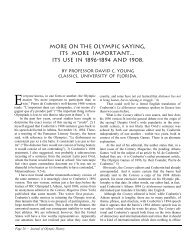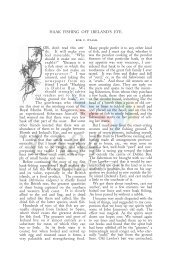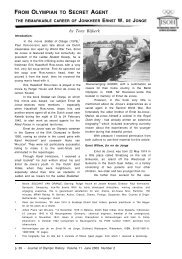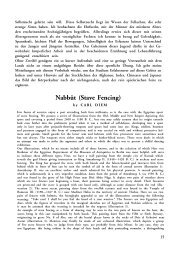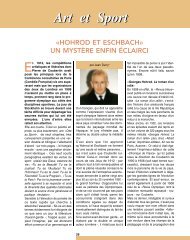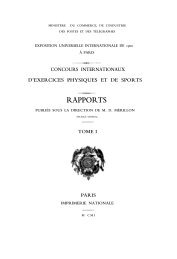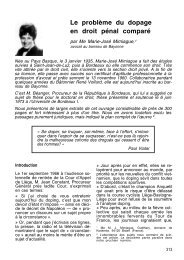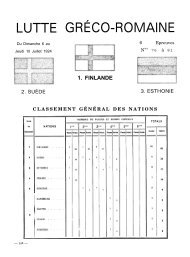Dreams Like Baseball Cards: Baseball, Bricoleur ... - LA84 Foundation
Dreams Like Baseball Cards: Baseball, Bricoleur ... - LA84 Foundation
Dreams Like Baseball Cards: Baseball, Bricoleur ... - LA84 Foundation
Create successful ePaper yourself
Turn your PDF publications into a flip-book with our unique Google optimized e-Paper software.
Winkler / <strong>Dreams</strong> <strong>Like</strong> <strong>Baseball</strong> <strong>Cards</strong> 87<br />
<strong>Dreams</strong> <strong>Like</strong> <strong>Baseball</strong> <strong>Cards</strong>:<br />
<strong>Baseball</strong>, <strong>Bricoleur</strong>, and the Gap in<br />
Sherman Alexie's The Lone Ranger<br />
and Tonto Fistfight in Heaven<br />
Scott A. Winkler<br />
Whoever wants to know the heart and mind o f America<br />
had better learn baseball.<br />
JACQUES BARZUN,<br />
God's Country and Mine, 1954<br />
I like your interest in sports—ball, chiefest of all—base-ball<br />
particularly: base-ball is our game: the American game: I<br />
connect it with our national character.<br />
WALT WHITMAN,<br />
<strong>Baseball</strong> is our game, 1888<br />
I • The Euramerican Game<br />
Jacques Barzun, the continental thinker who adopted America as his home,<br />
and Walt W hitman, the self-proclaimed poet o f America, the literary figure<br />
foretold by Emerson, may be separated by over one-half a century and radically<br />
different origins, but they express remarkably similar sentiments about<br />
baseball. In this deceptively simple sport that has been played in the United
88 Aethlon XXI:2 / Spring 2004<br />
States since the years leading up to the Civil War, Barzun and W hitm an locate<br />
the source of a fundamentally "American" character. This American character,<br />
however, is one that may more accurately be referred to as Euramerican character,<br />
for both Barzun and W hitm ans cultural touchstone is the dom inant American<br />
culture that grew along with the society constructed by European settlers<br />
w ho extended the borders of the United States further and further westward<br />
throughout the Eighteenth and Nineteenth Centuries, eventually fulfilling what<br />
was popularly referred to as the nation's Manifest Destiny.<br />
Manifest Destiny—and American Character—fail to account, however, for<br />
the original Americans. From the perspective of Manifest Destiny, American<br />
Indians were little more than an obstacle to be overcome as the engine of<br />
progress churned toward the inevitable realization of a nation spanning the<br />
N orth American continent. And from the perspective of W hitman and Barzun's<br />
"American character," American Indians are typically seen as savages (by turns<br />
noble or purely brutal in the dom inant narratives constructed to make sense of<br />
American history). It is, then, with a full awareness of the irony inherent in the<br />
subject of my examination that I seek to bring together literary constructions<br />
of American Indian identity and agency with baseball, a sport that would more<br />
accurately seem to align with the cultural conventions of Euramerican culture.<br />
Through the analysis of American Indian characters brought into contact with<br />
"the American game," we may discover that baseball is not so rigidly aligned<br />
with the cultural values of the dom inant Euramerican culture that it precludes<br />
these characters from constructing an identity and exercising a power (or agency)<br />
independent of cultural forces that may otherwise constrain them. In fact, baseball,<br />
because it is a game that exists in the kind of gap explored later in this<br />
essay, allows them to successfully perform these very tasks. Specifically, the<br />
American Indian characters in Sherman Alexie's The Lone Ranger and Tonto<br />
Fistfight in Heaven illustrate the possibilities inherent in a conception of "the<br />
American game" that extends beyond its apparent Euramerican limits.<br />
II. The Gap: It's Not About Khaki<br />
To address the issue of American Indian identity and agency means opening<br />
the proverbial can of worms (or Pandora's Box—you may select the metaphor<br />
of your choice), requiring the consideration of a host of questions: w hat<br />
is an American Indian? Is such an identity, to borrow the terminology set forth<br />
by Jana Sequoya Magdaleno, more accurately characterized as "tribal" or "ethnic"<br />
(280)? W hen we speak of identity, are we speaking of identity as constructed<br />
by the dom inant culture (i.e., the romanticized noble savage vanishing<br />
from the American landscape or the brutal m arauder terrorizing innocent<br />
settlers carving out an existence on the American frontier), or identity as constructed<br />
and asserted by a m em ber of the colonized culture (in whatever version<br />
that may be)? And perhaps m ost importantly, once we have agreed to the<br />
parameters established by answering these questions, where can we look for
Winkler / <strong>Dreams</strong> Line <strong>Baseball</strong> (Jards 89<br />
examples of successful identity construction, of meaningful agency, an d what<br />
are the conditions that enable such constructions and operations?<br />
For the purpose of this essay, "American Indian" will be defined as anyone<br />
possessing American Indian blood (Magdaleno's ethnic designation) and attem<br />
pting to live within the dom inant Euramerican culture on his or her own<br />
term s—not those set forth by the ideology of the dom inant culture (though<br />
this individual may appropriate the language and norms of the dom inant culture<br />
in the service of his or her goals). In answering the final question articulated<br />
in the preceding paragraph, I will look to the "gap" that factors prom inently<br />
in both the theory and practice of literature, a gap m ade m anifest in<br />
m ultiple narratives by and about American Indians and in the very structure of<br />
the sport of baseball.<br />
In the often contentious fields of literary theory and cultural study, the gap<br />
of which I speak takes on any of a num ber of permutations. Linguistically, the<br />
gap may be referred to as an aporia—an "'impasse' of an undecidable oscillation,<br />
as when the chicken depends upon the egg but the egg depends upon the<br />
chicken [and] the only way to claim that language functions perfomatively to<br />
shape the world is through a constative utterance" (Culler 101). Language, then,<br />
may be said to function w ithin this linguistic gap; it can never definitively<br />
position itself at either pole, and in its oscillation, it situates itself w ithin a gap,<br />
a position from which it effectively bridges the constative (read: utterances<br />
either true or false) and performative (read: utterances actually performing actions<br />
to which they refer) functions.<br />
Similarly, we can discover a gap within the field of myth theory, a gap with<br />
significant implications for the construction of American Indian identity within<br />
the American game. In her impressive study of mythic conventions w ithin the<br />
sport of baseball and the literature that has grown up around it, Deeanne<br />
Westbrook draws upon the linguistic roots of myth to situate the gap in which<br />
baseball functions. As she points out:<br />
The words language and myth have traveled together from a<br />
com m on origin. Both ... go back to a single Indo-European root,<br />
*ma-, realized in Greek as mythos, "word," "speech," and related<br />
to "mother" ... So myth is language ... [but] complicating the<br />
picture is the word mythology, which sometimes means simply<br />
'myths' but has traditionally been used ambiguously to mean<br />
both "a body of myths" and "the study of myths." The word<br />
(which combines mythos, "word," and logos, "word") is a reiterative<br />
term ... In Plato both mythos and logos could m ean "account" or<br />
"story," but the two terms were already taking on connotations,<br />
at times, of the "false" and the "true," or the narrative and<br />
discursive. (5)
90 Aethlon XXI;2 ] Spring 2004<br />
Such an understanding of myth situates a definite gap between narrative and<br />
discourse—between story and theory, between the presumed construction of<br />
something false and the apparent pursuit of truth—helping us understand the<br />
function myth serves in the m odern world. It is within this gap that Claude<br />
Levi-Strauss identifies the role of "mythic enterprise" (which W estbrook identifies<br />
as both the act of storytelling to make meaning in the w orld and the act<br />
of interpreting myth to consider its implications for the world) as "the work of<br />
the bricoleur, the artificer who 'make[s] do with whatever is available7 to construct<br />
a new thing, building, as Boas said, 'new mythological w orlds' from the<br />
shattered remains of the old" (Westbrook 5). In this sense, the bricoleur, be he<br />
storyteller or critic, carries out his work in the gap between narrative and discourse;<br />
this work, w hether it generates or interprets myth/narrative, effectively<br />
bridges the gap between the two—an act of bridging carried out by Sherman<br />
Alexie as he allows his American Indian characters to situate themselves in<br />
relation to the American game.<br />
Before examining Alexie's characters as bricoleurs, however, tw o tasks m ust<br />
be performed: first, the mythic character of baseball m ust be established, and<br />
second, examples of American Indian characters effectively constructing identity<br />
and exercising agency w ithin "gaps" must be briefly examined. In recent<br />
years, several critics and commentators have examined the mythic character of<br />
baseball (and indeed, fiction writers like W.P. Kinsella and filmmakers like<br />
Phil Alden Robinson have firmly entrenched the mythic w ithin their baseball<br />
narratives, encouraging such examinations), but perhaps the best exploration<br />
of the link between baseball and the mythic is presented by Roberta Newman<br />
in her essay "The American Church of <strong>Baseball</strong> and the National <strong>Baseball</strong> Hall<br />
of Fame." In this work, she makes a compelling argument in support of her<br />
assertion that "in this country, where the secular is frequently im bued w ith<br />
religious significance, baseball, the national pastime, may be said to serve as<br />
the American religion" (46). In this statement alone, we see evidence of the<br />
m anner in which the American game functions in the gap—in this case, in the<br />
space between the religious (read: myth/narrative, the performative) and the<br />
secular (read: discourse/theory, the constative); baseball, by being im bued with<br />
the characteristics o f both myth and religion, becomes the bricoleur Westbrook<br />
identifies in the theory o f Levi-Strauss. As Frank Hall notes, baseball fluctuates<br />
between the secular and religious poles, never resting wholly with the former<br />
because "with all its rituals and ceremonies, [baseball] certainly mirrors religion"<br />
or the latter as "it lacks a metaphysics. It may have saints and heroes, but<br />
baseball has no real sense of the divine" (qtd. in Newman 47). Though baseball<br />
may be im bued w ith elements of both the religious and the secular, it<br />
effectively exists in the gap between the two, allowing those who "worship" at<br />
its altar to find a kind of salvation not typically present in the secular world.<br />
Interestingly—and appropriately, given the objective of this essay—<br />
Newman's analysis of baseball's religious/mythic character goes on to include
Winkler / <strong>Dreams</strong> Line ttaseoau carets y i<br />
a notable discussion of American Indians, citing their importance in M orm on<br />
cosmology. In Mormonism, Newman locates a figurative link that helps her to<br />
articulate the religious nature o f baseball. She writes that "like America's game,<br />
M ormonism is an adaptation of an older, European religion, or, m ore appropriately,<br />
a group of religions, all labeled as Christianity .... However, th eir doctrine<br />
departs considerably from m ainstream Christianity just as rules o f baseball<br />
diverge from the rules of rounders" (48-49). She points out that in both<br />
the circumstances of its origin and the tenets of its beliefs, M orm onism is an<br />
American religion. Significant am ong these beliefs are the assertion th a t "Native<br />
Americans are the descendants of the lost tribe of Israel" and th a t with<br />
Christ's second coming "Zion w ould be built on the American continent" (49).<br />
In this sense, American Indians hold a privileged position, having already situated<br />
themselves in the only "home" that ultimately matters (the type o f mythic<br />
movement homeward that could be said to resonate in the m ovem ent of the<br />
successful batter in baseball returning to hom e plate). As such, they could be<br />
said to be gap dwellers; w ithin the fabric of the dom inant American secular<br />
narratives of progress, American Indians occupy a cultural and historical apo-<br />
ria—a gap in which positive identity is constructed and genuine agency functions<br />
when the American Indian becomes Levi-Strauss's bricoleur, able to link<br />
the sacred and the secular, able to bridge the gap between presumed and actual<br />
identity, at times ironically seizing upon the symbols and cultural currency of<br />
the dom inant culture in the process.<br />
Numerous American Indian texts w ithin this developing body of literature<br />
utilize the figure of the gap in performing their thematic work. In Leslie M armon<br />
Silko's Ceremony, Tayo exists in the gap between his Pueblo com m unity and<br />
the Euramerican culture that sent him to fight a war that would send him hom e<br />
as a damaged individual—and it is his ability to bridge the gap between the<br />
two (using elements of both his native and non-native cultures) that allows<br />
him to construct an identity we may assume will function successfully. N. Scott<br />
Momaday's House Made of Dawn begins and ends at dawn, the narrow gap<br />
between day and night, between the symbolic good and evil of the world, and<br />
by running within this gap, we see Abel symbolically attempting to strike a<br />
balance between the two. In Gerald Vizenor's Bearheart: The Heirship Chronicles,<br />
Proude Cedarfair is ultim ately situated in the gap between the natural and<br />
supernatural worlds, his laughter roaring "from the rim of the mesa in the west<br />
ha ha ha haaaa .... from the mesa in the east ha ha haaaa .... [moving] to the<br />
south and north in timeless flig h t.... over tim e in the four directions" (244).<br />
From this position, Proude Cedarfair may function as Vizenor's compassionate<br />
trickster. And in Thomas King's Green Grass, Running Water, American Indian<br />
storytellers exercise a unique agency from the space they occupy in the<br />
gap between narrative and discourse—they alter Judeo-Christian stories and<br />
figures w ithin Biblical narratives and alter the ending of a stereotypical Western<br />
film by having the Indians defeat lohn Wayne.
92 Aethlon XXL2 / Spring 2004<br />
Additionally, two figures that are characteristic of American Indian literature,<br />
the trickster and the mixedblood, could be said to exist w ithin the gap.<br />
Louis Owens argues that while the position of the m ixedblood "has alm ost<br />
universally been treated as the 'tragic' fact" (167), it need not be tragic. Such a<br />
position in the gap between cultures instead offers the m ixedblood a privileged<br />
position of power, and if he is able to bridge the gap between the two<br />
with the tools at his disposal (i.e., Silko's Tayo), the m ixedblood can act with a<br />
type of agency uniquely available to him only. Similarly, the trickster is positioned<br />
in a gap, fluctuating between creator and destroyer, between prom oter<br />
of the sacred and bringer of the profane. To paraphrase Kimberly Blaeser's exam<br />
ination of the trickster figure in the work of Gerald Vizenor, the trickster,<br />
w hen understood to possess transformative properties inherent in the figure,<br />
stimulates reader participation (13 7). In this sense, the trickster displays a truly<br />
remarkable type of agency; not only does he function from w ithin the gap in<br />
his narrative world, but he also actively works from a gap between the "real"<br />
and narrative worlds.<br />
Jerome DeNuccio identifies the gap existence in which the characters in<br />
Sherm an Alexie's The Lone Ranger and Tonto Fistfight in Heaven function.<br />
DeNuccio points to the storyteller Thomas Builds-the-Fire as the originator of<br />
the figure that enables a conception o f Alexie's characters as existing w ithin a<br />
gap. Thomas tells Junior and Victor that "your past is a skeleton walking one<br />
step behind you, and your future is a skeleton walking one step in front of you<br />
.... [but] w hat you have to do is keep moving, keep walking, in step w ith your<br />
skeletons .... That's what Indian tim e is. The past, the future, all of it is wrapped<br />
up in the now That's how it is. We are trapped in the now" (Alexie 21-22). O n the<br />
basis of being situated between the past and the future, DeNuccio argues that<br />
Alexie's characters are positioned "in a social space replete with memories,<br />
dreams, and voices that invite attention and response, that must be accommodated<br />
and negotiated if the self as an individual and a tribal subject is to emerge.<br />
Such negotiation, although param ount, is never easy" (87). Though the negotiation<br />
to which DeNuccio alludes may seem unsuccessful given the proclivity<br />
for tragedy that seems inherent in many of Alexie's characters, we can find,<br />
within their gap existence, a tool which enables them a greater degree of success<br />
than would otherwise be available in the construction of identity and the<br />
exercise of agency.<br />
That tool is baseball.<br />
III. But Can Tonto H it the Curveball?<br />
That sport may play a significant role in the construction of identity and<br />
exercise of power for American Indians—or for any m em ber of any group—is<br />
clearly an assertion possessing merit. Jacques Derrida, in his landmark essay<br />
"Structure, Sign and Play in the Discourse of the H um an Sciences" establishes<br />
the theoretical framework by which, according to Timothy Morris, sport (and
Winkler / <strong>Dreams</strong> <strong>Like</strong> <strong>Baseball</strong> <strong>Cards</strong> 93<br />
specifically in this instance, baseball) may be regarded as a centered structure<br />
(17). "Centering" would imply its existence between two structures—hence,<br />
an existence in a gap. Derrida writes that on this foundation, "anxiety can be<br />
mastered, for anxiety is invariably the result of a certain m ode of being im plicated<br />
in the game ... of being as it were at stake in the game" (qtd. in Morris<br />
18). By enabling participants to master anxiety, play/sport, then, m ay be said<br />
to function as bricoleur for those participants, bridging the gap between whatever<br />
poles create the anxiety brought to bear upon them. Similarly, Tewaarathon,<br />
a project of the North American Traveling College of the Akwesasne Mohawk<br />
Indian Reservation, examines the traditional American Indian sport o f lacrosse<br />
(interestingly, it is, like baseball, a game involving ball and stick) and its role in<br />
the lives o f the Akwesasne. A portion of the report states that lacrosse<br />
came from the creator himself, [and] was also played to bestow<br />
honour and respect to these members living on M other Earth<br />
w ho had done great things for the N ation. Related to this,<br />
Tewaarathon also constituted a means of offering thanksgiving<br />
to the Creator for having allowed an elder or medicine person to<br />
rem ain with the Nation so that the person could continue to<br />
share the richness of his full life with the younger members, (par.<br />
2)<br />
In this conception of tewaarathon, the sport enables its participants to forge an<br />
identity w ithin the gaps between the mortal and the immortal, between the<br />
past and the future—sport again effectively functions as Levi-Strauss's bricoleur,<br />
as Derrida's centered structure.<br />
That Alexie intends to link sport, identity, and agency in The Lone Ranger<br />
and Tonto is undeniable. Basketball is the sport m ost frequently m entioned in<br />
the text, but for all its popularity on the Spokane reservation where most o f the<br />
collection's stories take place, it fails to function as a productive venue for the<br />
construction of identity or the exercise of meaningful agency. As Alexie's narrator<br />
points out, "There's a definite history of reservation heroes who never finish<br />
high school, who never finish basketball seasons. Hell, there's been one or<br />
two guys who played just a few m inutes of one game, just enough to show<br />
what they could have been" (italics mine) (47). In basketball, potential remains<br />
unfulfilled, identity merely a partial, potential construction, and agency a fleeting<br />
display of prowess. Significantly, several characters throughout the text claim<br />
basketball wasn't created by James Naismith, but by Indians; this claim enables<br />
Alexie to present a symbolic example of Euramerican seizure of Indian<br />
land and culture with its attendant prevention of constructing identity and<br />
dem onstrating agency. In the collection's title story, we see Junior returning to<br />
the basketball court after several year's absence. After training himself for his<br />
return, "on the night I was ready to play for real, there was this white guy at the<br />
gym, playing with all the Indians. ... the new BIA chiefs kid .... [who] played
94 Aethlon XXI:2 / Spring 2004<br />
Indian ball, fast and loose, better than all the Indians there." Eventually, despite<br />
the fact that Junior "played well for a little while," the "white kid took<br />
over the game .... We just knew he was better that day and every other day"<br />
(188-189). The success of the "white kid" at what the text claims to be an<br />
indigenous game symbolically reconstructs the spread of Euramerican dom inance<br />
in N orth America.<br />
It is in baseball, however, that the tables are turned; it is the site where we<br />
see Indians seize upon the "American" game in a m anner showing that it is a<br />
truly American—not Euramerican—game. <strong>Baseball</strong> appears three times in The<br />
Lone Ranger and Tonto. Its first appearance is in "A Good Story," w hen Junior's<br />
mother, tired of stories that are "too sad," urges him to tell a story in which<br />
"good things happen." Junior agrees, but tells her that if she "wants to hear a<br />
good story, [she has] to listen" (140). The story he tells is easily the most benign,<br />
least tragic narrative in the collection. It focuses on Uncle Moses who sits<br />
"in his chair eating a sandwich ... [humming] an it-is-a-good-day song" (141).<br />
Moses waits for children to visit him, and when he sees them, they carry "dreams<br />
in the back pockets of their blue jeans, pulled them out easily, traded back and<br />
forth." U pon seeing this, Moses com ments that "dreams [are] like baseball<br />
cards" (142). In this tableau, Indian children are clearly in control of their<br />
dreams, the implication being that they need not have their identity or fate<br />
determ ined by a dom inant culture eager to tell them what is and is not good<br />
for them , how they should or should not structure their lives. And in the transform<br />
ation of dreams to baseball cards, we see a reversal in the roles of colonist/colonizer<br />
present on the North American continent, a reversal symbolically<br />
em bodied by an American game.<br />
<strong>Baseball</strong>'s second appearance in The Lone Ranger and Tonto occurs in "The<br />
Approximate Size of my Favorite Tumor," w hen the story's narrator, Jimmy<br />
discovers he has cancer. His tool for coping w ith the news of the cancer is the<br />
tool he utilizes when confronted with anything potentially destructive in his<br />
life—hum or. Jimmy tells the story of how he broke the news to Norma, his<br />
wife:<br />
I told her the doctor showed me my X-rays and my favorite tum or<br />
was just about the size of a baseball, shaped like one, too. Even<br />
had stitch marks .... I told her to call m e Babe Ruth. Or Roger<br />
Maris. Maybe even Hank Aaron 'cause there must have been about<br />
755 dam n tum ors inside me. Then, I told her I was going to<br />
Cooperstown and sit right down in the lobby of the Hall of Fame.<br />
Make myself a new exhibit, you know? Pin my X-rays to my chest<br />
and point out the tumors. W hat a dedicated baseball fan! What<br />
a sacrifice for the national pastime! (157)<br />
<strong>Baseball</strong> gives Jimmy the m etaphors he requires to secure a degree of power in<br />
a situation that could likely render him powerless—he constructs a functional
Winkler / <strong>Dreams</strong> <strong>Like</strong> <strong>Baseball</strong> <strong>Cards</strong> 95<br />
identity and exercises whatever agency he can in the face of a disease that will<br />
ultimately kill him. Jimmy's utilization of baseball as m etaphor for identity<br />
and agency again reveals the productive nature of baseball in this regard.<br />
Also worth noting are the names Jimmy uses in his gallows hum or. Each of<br />
the three players he identifies—Ruth, Maris, and Aaron—is known for his prowess<br />
in hom e run hitting, but each of the three players, like Jimmy, is also a gap<br />
figure. Babe Ruth, revered in his lifetime for his single-season and career hom e<br />
run records, has become the subject of revisionist history—the one-tim e hero<br />
who was once featured in newspapers a syndicated box entitled "What Babe<br />
Ruth Did Today" (Ward & Burns 164) is now as likely to have tales of alcoholism,<br />
overeating, and wom anizing attached to his name; Babe Ruth the m an is<br />
no longer a "god," yet his achievements elevate him well above the status of<br />
celebrity boor. In essence, his legacy is one that rests firmly in the gap between<br />
two extremes.<br />
Roger Maris, too, may be read as a gap figure. Most noted for breaking<br />
Ruth's single-season hom e run record by hitting 61 hom e runs in 1961, Maris<br />
did not receive the acclaim one might expect to accompany such an achievement.<br />
Instead, baseball commissioner Ford Frick suggested that "'some distinctive<br />
mark' appear next to Maris's achievement in the record books" (Ward<br />
& Burns 373) because he set the record over the course of a 162-game season as<br />
opposed to Ruth's 154-game season. Further driving Maris from the spotlight<br />
was the fact that he—a soft-spoken m an who eschewed the limelight—and not<br />
his m ore flamboyant, photogenic teammate, Mickey Mantle, broke the record<br />
(Mantle hit 54 during Maris's record-setting season). For as great as Maris's<br />
accom plishm ent was, it was not fully accepted or celebrated by either the public<br />
or the institution of baseball, effectively allowing him to dangle in a gap not<br />
o f his own making.<br />
And Henry Aaron, American baseball's all-time hom e run champion, also<br />
occupied a gap as he approached Ruth's record of 714 hom e runs. <strong>Like</strong> Maris,<br />
he was not a m edia darling—he did not possess the flair that could be found in<br />
several o f his m ore celebrated contemporaries. Also situating Aaron in the gap<br />
was his ethnicity. In the m onths leading up to his record-breaking home runs,<br />
Aaron received a great deal of hate mail, much of expressing sentiments like<br />
those presented in the crude poem "Hank Aaron": "With all that fortune,/and<br />
all that fame,/You're a stinkin' nigger, just the same" (Ward & Burns 429). He<br />
even received death threats. In a time that clearly should have been celebratory<br />
for Aaron (and he did receive such accolades), he also was forced to deal with<br />
threats and hate generated as a result of his ethnicity, mirroring circumstances<br />
often faced by American Indians and effectively placing him in a gap between<br />
being despised and being revered.<br />
But in each o f these instances, the player in question, like Jimmy, endured.<br />
Aaron and Maris kept playing in the face of criticism and under the lens of<br />
scrutiny, setting records that, over time, have come to take on genuine rever
96 Aethlon XXI:2 / Spring 2004<br />
ence; Ruth, for all the revisions now attached to him, cannot be separated from<br />
the im mensity of his legend, and he retains a unique position w ithin American<br />
culture. <strong>Like</strong> these three players, Alexie's Jimmy endures. Though Norma<br />
leaves him, ostensibly because she cannot bear his incessant joking, she returns<br />
to Jimmy from an affair with another m an who "was so fucking serious<br />
about everything" because "someone needs to help you die the right way ...<br />
and we both know dying ain't something you ever done before" (170). In<br />
Norma's reply to Jimmy, we see evidence of his work of the bricoleur—as a<br />
member of the Spokane tribe, as an American Indian living literally and figuratively<br />
in the gaps w ithin history, narrative, and myth, Jimmy has seized upon<br />
the m etaphors of the dom inant culture—and m ost significantly, upon the<br />
metaphorical power of the American game—and used them to successfully construct<br />
an identity, one he will presumably manage. To paraphrase the term inology<br />
of DeNuccio, baseball has offered him what he needs to negotiate his<br />
identity.<br />
In Alexie's final use of baseball in The Lone Ranger and Tonto, nam ing also<br />
plays a prom inent role in the negotiation of identity. Norma, who is perceived<br />
by Junior as a "cultural lifeguard," (199) assigns him a new name: Pete Rose.<br />
The new nam e comes about as a result of Junior sharing the story of how he,<br />
along with several white college classmates, harass an African American basketball<br />
player who had been released from prison but had "made it to college<br />
and was playing and studying hard. " Junior, upon reflection, states that "if you<br />
think about it, he and I had a whole lot in common. Much more in com m on<br />
than I had with those white boys I was drunk with" (208). In this instance, we<br />
can again see the dom inance of Euramerican culture figured in the symbolism<br />
of basketball, a process in which even Junior participates. But we again see the<br />
appropriation of baseball as a tool in constructing genuine identity. After hearing<br />
Junior's story, Norm a treats him differently for a year: "She wasn't m ean or<br />
distant. Just different. But I understood" (209). That different treatm ent ends<br />
when she walks up to Junior at the Trading Post:<br />
"Pete Rose," she said.<br />
"What?" I asked completely confused.<br />
"Pete Rose," she repeated.<br />
"What?" I asked again, even more confused.<br />
"That's your new Indian name," she said. "Pete Rose .... Because<br />
you two got a whole lot in com m on .... Pete Rose played<br />
m ajor league baseball in four different decades, has more hits<br />
than anybody in history. Hell, think about it. Going back to Little<br />
League and high school and all that, he's probably been smacking<br />
the ball around forever. Noah probably pitched him a few<br />
on the Ark. But after all that, all that greatness, he's only remembered<br />
for the bad stuff." (209-210)
Winkler / <strong>Dreams</strong> <strong>Like</strong> <strong>Baseball</strong> <strong>Cards</strong> 97<br />
In this exchange, in the assignation of a "new Indian name," we see Norma<br />
function as bricoleur; by giving Junior the nam e of a baseball player, she has<br />
effectively appropriated Euramerican cultural currency. She enables Junior to<br />
identify with a representative of the dom inant culture, acknowledging what<br />
DeNuccio calls "a com m onality of experience that frankly concedes not just<br />
[Junior's] error, but also its ineradicability, its permanence," a condition whose<br />
acceptance DeNuccio correctly identifies as "requiring] courage and breaking]<br />
the cycle by which past failures are repeated in the present" (93-94). But that<br />
error becomes acceptable in the guise of Junior's new identity—an identity<br />
that can only succeed on the fertile ground within the gap occupied by a truly<br />
American game, one that functions as bricoleur between myth and discourse,<br />
between the sacred and the secular, between colonizer and colonized, and between<br />
the competing narratives of history. In this sense, both Barzun and<br />
W hitman's remarks take on an unintended, but nonetheless significant, resonance,<br />
especially for American Indian characters situated in relation to a game<br />
that is, truly and wholly, American—situated in the gap that is baseball.<br />
Works Cited<br />
Alexie, Sherman. The Lone Ranger and Tonto Fistfight in Heaven. New York: HarperPerennial, 1993.<br />
Barzun, Jacques, God's Country and Mine. Dawidoff 256-259.<br />
<strong>Baseball</strong> as America. Washington, D.C.: National Geographic, 2002.<br />
Blaeser, Kimberly M. "Trickster Signatures." Gerald Vizenor: Writing in the Oral Tradition. Norman:<br />
University o f Oklahoma Press, 1996, 136-163.<br />
Culler, Jonathan. Literary Theory: A Very Short Introduction. Oxford: Oxford UP, 1997.<br />
Dawidoff, Nicholas, Ed. <strong>Baseball</strong>: A Literary Anthology. New York: Library o f America, 2002.<br />
DeNuccio, Jerome. "Slow Dancing with Skeletons: Sherman Alexie's The Lone Ranger and Tonto<br />
Fistfight in Heaven." Critique 44.1 (Fall 2002): 86-96.<br />
Hall, Frank. "Sacred <strong>Baseball</strong>." Newman 47.<br />
King, Thomas. Green Grass, Running Water. New York: Bantam, 1993.<br />
Magdaleno, Jana Sequoya. "How(!) is an Indian? A Contest o f Stories, Round 2." Postcolonial Theory<br />
and the United States: Race, Ethnicity, and Literature. Ed. Amrijit Singh & Peter Schmidt. Jackson:<br />
University Press of Mississippi, 2000. 279-299.<br />
Momaday, N. Scott House Made of Dawn. New York: Harper & Row, 1968.<br />
Morris, Timothy. Making the Team: The Cultural Work of <strong>Baseball</strong> Fiction. Urbana: University of<br />
Illinois Press, 1997.<br />
Newman, Roberta. "The American Church of <strong>Baseball</strong> and the National <strong>Baseball</strong> Hall of Fame."<br />
Nine. 10.1, 47-63.
98 Aethlon XXI:2 / Spring 2004<br />
Owens, Louis. "'The Very Essence o f Our Lives': Leslie Silko's Webs of Identity." Other Destinies:<br />
Understanding the American Indian Novel. Norman: University of Oklahoma Press, 1992. 167-<br />
191.<br />
Silko, Leslie Marmon. Ceremony. New York: Penguin, 1986.<br />
"Tewaarathon." Akwesasne Mohawk Indian Reservation: North American Traveling College. E-<br />
mail to the author. 30 April 2003.<br />
Vizenor, Gerald. Bearheart; The Heirship Chronicles. Minneapolis: University of Minnesota Press,<br />
1978 & 1990.<br />
Ward, Geoffrey C. & Ken Burns. <strong>Baseball</strong>: An Illustrated History. New York: Knopf, 1964.<br />
Westrook, Deeanne. Ground Rules: <strong>Baseball</strong> & Myth. Urbana: University o f Illinois Press, 1996.<br />
Whitman, Walt. "Base-ball is our game." <strong>Baseball</strong> as America 37.



